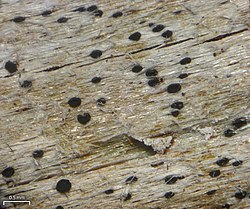Description
Bactrospora forms a thin, crust-like thallus that either sits on the bark surface or sinks slightly into it. The crust is usually continuous and even, though older colonies may crack into an irregular mosaic, and its surface can appear scurfy or powdery. Because a true cortex —the protective outer skin found in many lichens—is missing, the fungal layer merges directly with the algal partner. The photobiont is the orange-tinged green alga Trentepohlia , whose cells become visible and stain the thallus orange when the surface is gently scratched. A prothallus (an outer fringe of pure fungal tissue) is poorly developed and often escapes notice. No characteristic lichen products have been detected with thin-layer chromatography. [3]
The fruit bodies of Bactrospora are tiny, black to black-brown discs (apothecia) that sit on the thallus without a rim of surrounding tissue (a thalline margin ). Their own wall, the exciple , stays conspicuous; it is dark red-brown at the edge but becomes paler further in, and a drop of potassium hydroxide solution (KOH) turns this pigment an olive-black. Internally, the clear (hyaline) hymenium contains stout, sparsely branched paraphysoids whose tips interlink to form a cap ( epithecium ) ranging from pale to dark red-brown. Each ascus follows the Opegrapha -type fissitunicate pattern: its wall splits apart when the spores are released, and an iodine staining may reveal a faint blue dome over the tiny ocular chamber at the apex. [3]
Ascospores are elongated, thin and needle-like, divided by dozens of internal walls. Mature spores frequently break up into smaller spherical or short-cylindrical part-spores, so older asci often appear to contain many more than the original eight. Asexual reproduction occurs in flask-shaped pycnidia embedded in the thallus; these produce colourless, rod-shaped conidia that escape through a dark-brown pore whose pigment also turns green-black in KOH. Bactrospora is usually corticolous, colonising the bark of trees in shaded, humid habitats, and can be told apart from related genera such as Lecanactis and Cresponea by its extremely multiseptate, fragmentation-prone spores. [3]
This page is based on this
Wikipedia article Text is available under the
CC BY-SA 4.0 license; additional terms may apply.
Images, videos and audio are available under their respective licenses.

